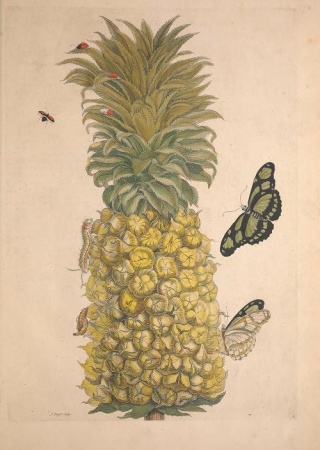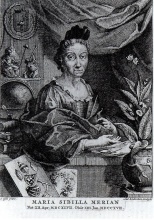Maria Sibylla Merian
- The notebooks containing Maria’s biological research, which she began in Frankfurt in 1660 and continued until her death in 1717, were purchased on the day of her funeral by an agent of Peter the Great, who was interested in naturalist studies.
- Intellectual women like Maria were under threat of being considered witches, especially in 17th-cenury Germany, where extensive knowledge of “worms” (caterpillars) was considered inappropriate for women.
- It was believed that what your mother looked at during her pregnancy and while giving birth would influence the unborn child for life, and Maria’s mother had looked at an insect collection while pregnant.
- In the European guild systems, women could only work in watercolors, not in oils, and Maria’s work was all in watercolor.
- Maria’s daughter, Dorothea, and her husband, George Gsell, worked for czar Peter the Great in St. Petersburg; Dorothea was the first woman to receive a commission to design exhibits and document artifacts in watercolor, keeping track of the czar’s natural history collection.
- Maria’s other daughter, Johanna, ran an orphanage in Suriname with her husband, and sent preserved specimens back to Europe for collectors.
- Both of Maria’s daughters continued to engrave Maria’s paintings and publish her works after her death.
- April 2, 1647 Maria is born.
- At age 13, she develops a love of caterpillars, butterflies and metamorphosis, and begins keeping extensive scientific journals until her death.
- At age 16, she marries Johann Graft (artist's apprentice).
- Soon after marriage, she gives birth to two daughters, Johanna and then Dorothea.
- 1675-1680 She publishes her three-volume work on new flowers (Neues Blumenbuch).
- 1679 Maria publishes a book on caterpillars (Der Raupen wunderbare Verwandelung).
- 1699 Maria makes a trip to Suriname at age 52; she brings her youngest daughter, Dorothea.
- 1705 She publishes her work on specimens studied in Suriname (Metamorphosis Insectorum Surinamensium).
- January 13, 1717 Maria passes away.
Maria Sibylla Merian (1647-1717) is considered the first person to travel purely to engage in scientific research (while men often conducted such research it was in addition to other primary jobs). Maria was born in Frankfurt, Germany, and then made a living by painting designs onto silks, satins and linens in Nurnberg and Amsterdam. Like many women naturalists prior to the twentieth century, she was self-taught in biology. Maria published a three-volume work on caterpillars, with the support of a group of Nurnberg poets interested in science.
At the age of 52, in 1699, Maria had saved up enough money to travel to Suriname, South America to study moths, butterflies and metamorphosis. Two years into this planned five-year trip, Maria took ill with what was probably malaria and had to return home to Europe, where she was ill and destitute. She was forced to sell some of the biological specimens she had brought back from Suriname. She finally published a portfolio-sized work containing 60 illustrations, with text in Dutch and Latin, and continued to support herself by selling her work until her death in 1717.




